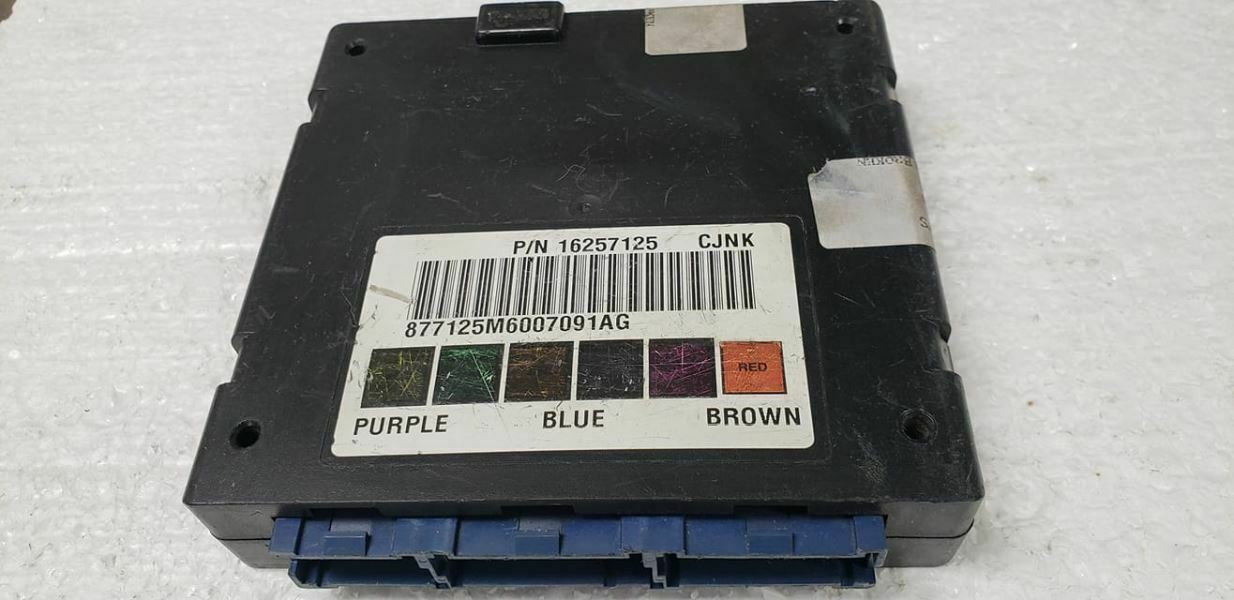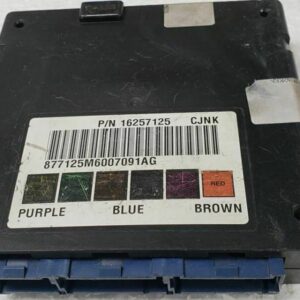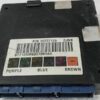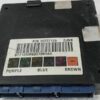Restore Your Truck’s Electrical System with a Reliable BCM
Are you chasing down electrical gremlins in your 1998-2000 GM truck or SUV? One minute the dome light won’t turn off, the next the power locks are acting on their own. As a technician with over two decades of experience, I’ve seen these exact issues hundreds of times, and they almost always point to a failing Body Control Module (BCM). This isn’t just an inconvenience; a faulty BCM can affect vehicle security, lighting, and even its ability to start. This is the central hub for your vehicle’s body electronics, and when it fails, it creates chaos.
We offer a straightforward, dependable solution. This BCM, compatible with part number 16257125, arrives at your door pre-programmed to your vehicle’s specific VIN. This crucial step ensures seamless integration with your truck’s existing systems, loading the latest GM software updates for optimal performance. You get a reliable part that’s ready to install right out of the box, eliminating the need for an expensive trip to the dealership for programming.
Case Study: A Tricky Diagnosis
A 1999 Silverado 1500 came into my bay with a complaint that was driving the owner crazy: the radio would randomly turn off, the security light would flash, and sometimes the truck wouldn’t crank. The battery was new, and the alternator checked out. After scanning for codes, I found a series of communication errors (U-codes) all pointing back to one component. By monitoring the data stream from the 1998-2000 GM BCM, I could see it dropping offline intermittently. The internal circuits were failing from age and heat cycles. We replaced it with a VIN-programmed module, and all the bizarre electrical issues vanished instantly. It’s a classic failure mode for these otherwise tough trucks.
Is Your Truck Exhibiting These BCM Failure Signs?
A failing BCM can manifest in numerous ways. If you’re experiencing any of the following, it’s a strong indicator that your Body Control Module needs attention:
- ✔ Erratic power windows, door locks, or mirrors.
- ✔ Interior or exterior lights that won’t turn on or off, or that flicker randomly.
- ✔ The security or anti-theft system malfunctioning, preventing the vehicle from starting.
- ✔ Horn honking unexpectedly or not working at all.
- ✔ Intermittent issues with the radio or instrument cluster displays.
- ✔ Diagnostic Trouble Codes (DTCs) related to lost communication, such as U0140.
- ✔ Wipers operating on their own or not responding to the switch.
A Straightforward Guide to BCM Installation
Replacing the BCM is a manageable job for a DIYer with basic tools. While the exact location can vary slightly, this general guide will get you through it.
- Safety First: Always disconnect the negative terminal from your vehicle’s battery and wait a few minutes to ensure all systems are powered down.
- Locate the BCM: On most of these GM trucks and SUVs (like the S10/Blazer or Silverado/Sierra), the BCM is located under the driver’s side or center of the dashboard. It’s a black plastic box with several large electrical connectors.
- Remove Connectors: Carefully unplug all wiring harnesses from the old BCM. These connectors have locking tabs that need to be depressed or levers that need to be swung to release them. Do not force them.
- Swap the Module: Unbolt or unclip the old BCM from its mounting bracket. Secure the new, pre-programmed module in its place.
- Reconnect Everything: Plug all wiring harnesses firmly into the new BCM. You should hear or feel a click as they lock into place. Reconnect the negative battery terminal.
- Post-Installation Checks: Turn the key to the ‘On’ position and test all body functions—lights, locks, windows, wipers, etc. Start the vehicle. Note that some additional steps may be required, as outlined below.
Important Post-Installation Procedures
After installing your new 1998-2000 GM BCM, your vehicle may require one or more of the following procedures for full functionality. This is a normal part of the process when replacing a key electronic module.
Airbag System Sync: If your airbag warning light is illuminated after installation, the new BCM needs to be synced with the airbag’s computer (SDM). This requires a professional scan tool to perform the ‘Setup SDM Primary Key in BCM’ procedure. This is only necessary if the light stays on.
Brake Pedal Position Relearn: On some models, a brake pedal position sensor recalibration might be needed. This ensures your brake lights and any associated traction control systems function correctly. This can often be done with a capable bidirectional scan tool.
Verified Fitment For Your GM Truck or SUV
This module is a direct replacement for part number 16257125 and other interchangeable numbers. Please verify your part number before ordering. This part is confirmed to fit the following vehicles:
- ✔ Astro Van: 2000 (LH dash)
- ✔ Blazer S10 / Jimmy S15: 1998-2000 (center dash, ID 16257125)
- ✔ Bravada: 1998 (center dash, w/ extended build date opt ZN4)
- ✔ Isuzu Hombre: 1999-2000 (LH dash)
- ✔ S10 / S15 / Sonoma Pickup: 1998-2000 (center dash, ID 16257125)
- ✔ Safari (GMC): 2000 (LH dash)
- ✔ Sierra / Silverado 1500 & 2500: 1999-2000 (LH dash)
Frequently Asked Questions
Do I need to send you my old BCM?
No, there is no core charge for this part. You can keep your original module, which can be helpful for reference or as a backup.
Why do you need my VIN number?
We require your Vehicle Identification Number (VIN) to program the BCM with the correct software and vehicle-specific settings from GM. This ensures it communicates properly with your truck’s other modules, making the installation process as simple as possible.
What exactly does a Body Control Module do?
The BCM is like the central nervous system for your vehicle’s comfort and convenience features. It controls non-engine-related functions like power windows, interior/exterior lighting, door locks, the alarm system, and wipers.
Will this fix my ‘Service 4WD’ light?
While the BCM can be involved, a ‘Service 4WD’ light is more commonly caused by the Transfer Case Control Module (TCCM) or the encoder motor on the transfer case. It’s best to have the codes read with a proper scanner to pinpoint the exact cause before replacing parts.
What tools are needed for the post-installation procedures?
The Airbag System Sync and Brake Pedal Position Relearn procedures require a professional-grade bidirectional scan tool, such as a Tech 2, Snap-on, or Autel unit, that can perform specific commands. Many local repair shops can perform these relearns for you if needed.



